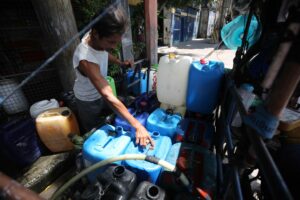THE PHILIPPINES needs coordinated efforts among stakeholders to address its water supply challenges, with an estimated investment of P250 billion needed to serve 40% of the population, an official from Department of Environment and Natural Resources (DENR) said.
“There’s still 40% of our population that does not have a formal supply of water… to provide water to the 40%, we need P250 billion,” DENR Undersecretary Carlos Primo C. David told reporters on Tuesday.
“We’ve been spending pero hindi siya nababawasan kasi hindi coordinated ’yung efforts natin (but it’s not decreasing because our efforts are not coordinated). So I think, once we coordinate it, that P250 billion, that would be easy,” he added.
The DENR announced last year that there are 135 potential water projects to be offered in 2024.
The sites being put up for public-private partnerships hold water rights via the National Irrigation Administration (NIA).
The projects are located within rivers with NIA’s structures such as dams, where water not used for irrigation can be repurposed for potable water or hydropower.
Mr. David recently announced an additional 112 water projects, which involve a combined capacity of 100 to 170 million liters per day, as part of the second batch that is up for public-private investments.
“Now, we can use water as well as the facilities that belong to NIA for various purposes, including power generation and bulk water supply,” he said.
Executive Order No. 22 created the Water Resources Management Office under the DENR to coordinate government efforts for water availability and sustainable management.
In a separate interview, Luke Foley, head of technical assistance at the Private Infrastructure Development Group (PIDG), observed a favorable market for the private sector in the Philippines.
“I think that steps being taken to date in terms of actually organizing the regulatory environment is music to the private sector’s ears, so I think what would be the challenge now is taking what’s on paper and making it reality,” he said.
Mr. Foley said that there is “a good work that has been done today on behalf of the government and also from the private sector in terms of some of the proposals that [are] being submitted.”
PIDG is an infrastructure development and finance organization that was established in 2002, seeking to accelerate sustainable infrastructure throughout South and Southeast Asia and sub-Saharan Africa.
Among PIDG’s major projects in the Philippines are a portfolio of four run-of-river mini-hydropower projects in North Luzon with a total estimated capacity of 37 megawatts.
In 2016, InfraCo Asia Development Pte. Ltd., an infrastructure and investment company managed by PIDG, entered into a joint investment and development agreement and a convertible loan agreement with Alternergy Hydro Partners Corp. (AHPC).
InfraCo Asia provided a $2 million convertible loan on a “revolving basis” to AHPC, allowing it to develop the projects to a stage where it could “successfully attract private sector investment and repay the loan” to the former by 2021.
“The overall project is about $140 million. It’s a very large project across four different sites but the idea is to use it as a platform, potentially build up beyond the four [projects]… which we helped initiate with our early funding,” Mr. Foley said. — Sheldeen Joy Talavera
